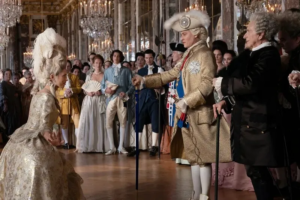By GREG KING
Director: Gurinder Chadha
Stars: Hugh Bonneville, Gillian Anderson, Michael Gambon, Simon Callow, Manish Dayal, Huma Qureshi, Lily Travers, Om Puri, Simon Williams, Lucy Fleming.

India, 1947. Financially weakened by the cost of fighting WWII, the British government is planning to pull out of India, leaving the country to become an independent nation. Sent to oversee the transition from a colony of the fading British Empire to independence is Earl Mountbatten (Hugh Bonneville, from tv series Downton Abbey, etc), the great grandson of Queen Victoria. Initially Mountbatten was confident that he could oversee a smooth and peaceful transition, but India was a complicated place, divided by race, class and religion.
Mountbatten, his wife and daughter moved into the opulent palace that was home to the Viceroy – one of the largest private residences in the world, with over 500 servants. The film has a sort of Upstairs/Downstairs structure to it with two narrative strands running parallel. In the lavishly appointed offices and meeting rooms upstairs Mountbatten had to negotiate with the various leaders, including Gandhi, Nehru and Jinnah, who is now recognised as the father of modern Pakistan. Meanwhile his wife Edwina (Gillian Anderson, best known for her role in the long running sci-fi series The X-Files, etc) had a genuine concern for the people of India and tried to work with many of the downstairs servants. She even dismissed long serving retainers if they were disdainful on the Indian servants.
And there is also a Romeo and Juliet-like subplot concerning Jeet (Manish Dayal, from The Hundred Foot Journey, etc), a Hindu who is one of Mountbatten’s personal valets, and Aalia (Huma Qureshi, from Gangs Of Wasseypur, etc), a Muslim translator who works closely with the Mountbatten’s daughter Pamela. This story about star-crossed lovers is used to illustrate the deep seated religious divide within India itself, and their troubled romantic journey parallels the different paths of India. However, this subplot lacks originality and seems to follow a number of familiar tropes.
As the day of independence draws closer, tensions run high, not only in the Viceroy’s House, but on the streets of Delhi itself. Violence erupts across India. Eventually, Mountbatten was forced to fall back on a previously drawn up plan to partition India along religious lines and create a new Muslim state called Pakistan. This decision ultimately led to the creation of one of the biggest refugee crisis the world had witnessed, with s couple of million displaced persons forced into sprawling, overcrowded and squalid refugee camps.
The partition of India is a controversial topic and one that filmmakers have been reluctant to tackle – it was one of the themes explored in Richard Attenborough’s Oscar winning epic Gandhi – for a variety of reasons. However, filmmaker Gurinder Chadha (best known for her feel-good drama Bend It Like Beckham) has a personal connection to the story – her grandmother was one of those refugees. But Chadha also felt that with Brexit, the divisive politics of hatred that we see in the world, the story has a lot of topical resonance, and now was the time for it to be told.
Chadha doesn’t shy away from the horrors and the violence in the lead up to partition, and she deftly incorporates some archival newsreel footage to add to the feel of authenticity.
Chadha wrote the script with her husband and regular collaborator Paul Mayeda Berges, and Moira Buffini (Jane Eyre, etc). She draws upon historical records to shape the story, and there is also some carefully integrated newsreel footage that gives us further glimpses into the turbulent time. There is also some sly humour here at the expense of the pompous British bureaucrats and their sense of self-importance.
The film tackles big and important themes of geopolitics, cultural differences, the fading colonial past, immigration and refugees, the politics of hate, religion. There is a healthy dose of cynicism as it explores the machinations of politicians as they attempt to shape the world around them. Viceroy’s House also explores that complicated historical relationship between England and India and gives us some insight into this turbulent era.
Chadha is largely sympathetic in her treatment of Mountbatten, treating him less harshly than history has. Bonneville brings dignity and intelligence and un upbeat quality to his performance as Mountbatten. Anderson brings a flinty quality and strength of purpose to her portrayal of Edwina Mountbatten, a woman loyal to her husband but probably more aware of the enormity of the situation he faces. The supporting cast includes Simon Callow, Michael Gambon, and the last performance from veteran Indian actor Om Puri, who plays Aalia’s blind and ailing, but pragmatic father.
Chadha gives the film the epic sweep and visual beauty of the films of David Lean. It has been beautifully shot on location by cinematographer Ben Smithard (The Second Best Exotic Marigold Hotel, etc), who creates a wonderful contrast between the lavish environment of the Viceroy’s house and the squalor of the streets of the outlying villages beyond Delhi. A R Rhaman ( a frequent collaborator with Danny Boyle) has created an evocative score that adds to the film’s local colour and flavour.
★★★



